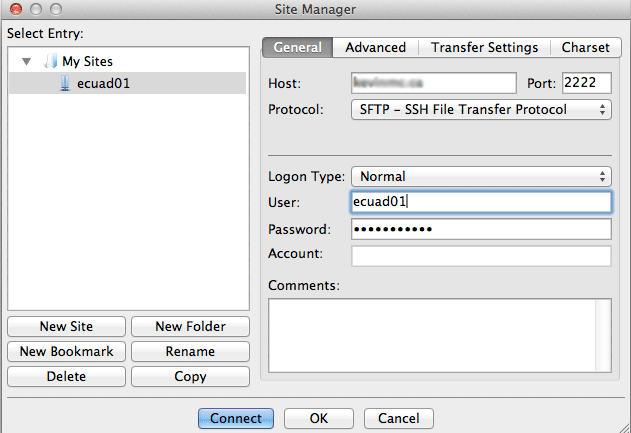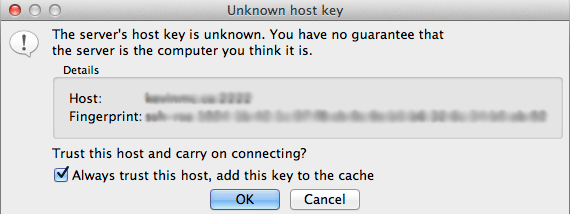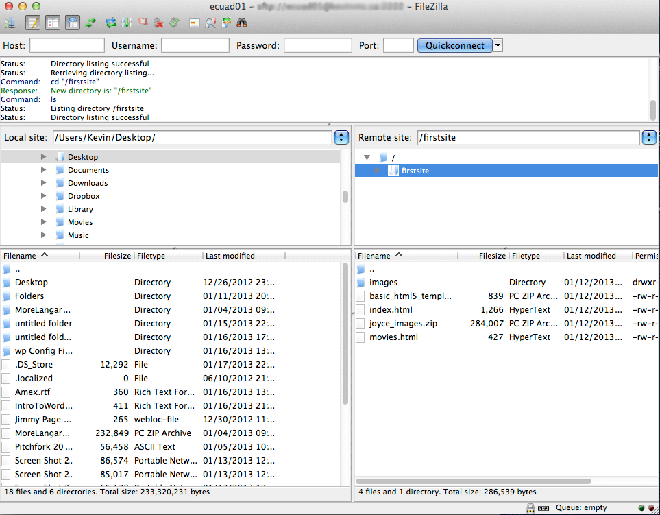Preamble
Elsewhere on this site, I show you how to use Fetch for FTP. This page will show how to use Filezilla to do the same thing.
Unlike Fetch, Filezilla is available on Windows (as well as Mac). It’s also free to download and use. You can get it here.
The screenshots below are from the Mac version of the program. I don’t anticipate there being other than cosmetic differences between the Mac and Windows interfaces. If there are, however: my apologies.
I have also blurred the occasional field in the screenshot, for security reasons.
Your Site SFTP Settings
It’s a bit more complicated to use SFTP with Filezilla than with Fetch, but not too much.
First of all, go into Site Manager. You get there by selecting the first item in the File menu. Click on the New Site button.

Give it a name. I called mine “ecuad01.” Call yours whatever helps you remember what project or website these settings are for.
Change the protocol here to SFTP—SSH File Transfer Protocol.
Change the login type to Normal.
If you are a Langara student, for the Host use mylinux.langara.ca and for the User & Password use the same credentials that you use to login to the Langara lab computers or myfiles.
If you are an Emily Carr student, in the Host, Port, User, & Password fields, enter the values I give you in class.
Click the Connect button.
You will then see a dialog box saying that there is an Unknown host key. Click on the “Always trust this host, add this key to the cache” button.

You should now be able to connect without a problem.
What’s more, in future, you can just go File < Site Manager and click on Connect. In other words, you shouldn’t have to enter the login details, hostname, or port any more.
Like a lot of FTP programs, Filezilla shows you two panes: Local Site and Remote Site. The local site is just a view of files on your own computer. The Remote site will show the contents of the directory on your server.

Transferring Files
On the Mac, you can drag and drop to and from the Remote Site pane. If you can’t do that on Windows, just select the files you want to upload from the Local Site pane, then right-click and choose Upload.
Similarly, you could download the same way. First, though, make sure you navigate in the Local Site pane to where you want the files to end up (on your own computer) when you do the download.
Similarly, before you move files from your computer to the server make sure you’re in the correct folder on the Remote side (more below on this, if that’s not clear).
Making Sure it All Worked
As noted above, before you move files from your computer to the server, you need to make make sure that you are in the directory you need to be in on the Remote side of the Filezilla window.
On some servers, like mylinux at Langara, that directory is called public_html. On others, it might be called www (or some other name).
If you put a file directly into that public_html folder (using Langara as an example), your URL will be like this:
https://mylinux.langara.bc.ca/~YOUR_ID/filename.html
If the file is called index.html, it will load automatically (ie you won’t have to specify the filename, just the domain, or, as we will see with the next example, the parent folder).
If you upload a folder to the public_html directory, the URL will be
https://mylinux.langara.bc.ca/~YOUR_ID/foldername
This assumes, of course, that you have an index.html file inside that folder.
The file index.html is, as you’ve probably guessed, a special file because it shortens the URL: we can end the path with the domain (www.apple.com) or the folder name (www.apple.com/iphone).
Once you’ve uploaded, definitely test the URL(s) in a web browser, on desktop and phone.
If It Didn’t Work…
If the URL didn’t work, check that
- you have uploaded to the “live” part of your hosting account (in the Langara example, the public_html folder)
- you have included an index.html file
- you have included the tilde (~) character in the URL (for myLangara, at least). In UNIX, tilde means the home directory of …
If Some Links Don’t Work
- make sure that all the files transferred
- make sure that you do not have case mismatches.
It’s probably best to just use lower case so you don’t have to worry about this.